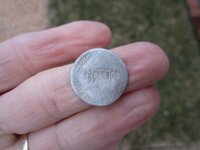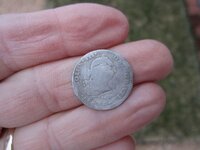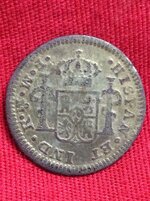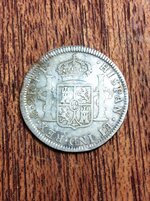Navigation
Install the app
How to install the app on iOS
Follow along with the video below to see how to install our site as a web app on your home screen.
Note: This feature may not be available in some browsers.
More options
You are using an out of date browser. It may not display this or other websites correctly.
You should upgrade or use an alternative browser.
You should upgrade or use an alternative browser.
Strange 1772 Half Real/Cuff Link
- Thread starter Ahab8
- Start date
Cross Potent
Hero Member
- Oct 20, 2014
- 651
- 656
- Detector(s) used
- XP DEUS
- Primary Interest:
- Relic Hunting
pong12211
Bronze Member
- Jan 5, 2013
- 2,487
- 947
- Detector(s) used
- Garrett at pro/Garrett pro pointer
- Primary Interest:
- All Treasure Hunting
Looks real to me too. Nice find.
Ahab8
Gold Member
- Oct 15, 2013
- 8,408
- 8,289
- 🥇 Banner finds
- 2
- Detector(s) used
- Teknetics T2 SE w/15' SEF Coil/ Minelab GPX 4500/2 Garrett Pro Pointers/3 Sets Killer B Headphones/ Koss Headphones/ Detekniy Wireless headphone Adapter
- Primary Interest:
- All Treasure Hunting
- Thread starter
- #4
So are they different on different denominations. It's backwards compared to the other Spanish I've found
Bill D. (VA)
Silver Member
Abe - here's one of my one reales from the same mint and with the same assayers. But mine is different than yours. Maybe they changed the dies yearly, or whenever it was needed, and the one used to make yours had the assayers initials flipped by mistake. But I still say that from the look of your coin that it's got a good chance to be a fake.




Ahab8
Gold Member
- Oct 15, 2013
- 8,408
- 8,289
- 🥇 Banner finds
- 2
- Detector(s) used
- Teknetics T2 SE w/15' SEF Coil/ Minelab GPX 4500/2 Garrett Pro Pointers/3 Sets Killer B Headphones/ Koss Headphones/ Detekniy Wireless headphone Adapter
- Primary Interest:
- All Treasure Hunting
- Thread starter
- #6
Abe - here's one of my one reales from the same mint and with the same assayers. But mine is different than yours. Maybe they changed the dies yearly, or whenever it was needed, and the one used to make yours had the assayers initials flipped by mistake. But I still say that from the look of your coin that it's got a good chance to be a fake.
View attachment 1106413
View attachment 1106414
Thanks buddy. I was starting to think I was losing my mind. Nobody else seemed to see it. All of my others are the opposite way. And the edges just don't look right to me. Glad you chimed in bud
Iron Patch
Gold Member
- Sep 28, 2007
- 19,254
- 8,732
- 🥇 Banner finds
- 3
- Detector(s) used
- Deus
- Primary Interest:
- All Treasure Hunting
looks good to me!
The text was just as important to add as the pic.
[h=1]Mexico 1772-Mo FM 1/2 real[/h]


from the Mountain Groan Collection


Shown is an 1772MoFM half real, one of a type struck 1772-84. The dates 1772-73 are distinguished from later issues by possessing inverted mintmark and assayers' initials on the reverse. The bust of Charles III was used until 1789 but later issues were of slightly lower fineness and are catalogued as a separate sub-type. Assayer FM is recorded for the years 1772-78. The half real, as one-sixteenth of a dollar, would have traded in the United States for 6½¢. Harris[SUP][1][/SUP] notes that the Mexico City half real is the only mint that can be called abundant for Charles III, the second mint, Potosi, is less than half as common.
Recorded mintage: unknown.
Iron Patch
Gold Member
- Sep 28, 2007
- 19,254
- 8,732
- 🥇 Banner finds
- 3
- Detector(s) used
- Deus
- Primary Interest:
- All Treasure Hunting
BTW... your coin does not appear to be silver, or at least a high grade silver, so it's likely cast. The error which you thought it might be with the last three letters seeming to run the opposite way is plenty possible, but it's almost always the result of an incorrectly engraved die... so those two things did not really jive with your coin initially, but now realizing it's a cast copy of a genuine inverted mintmark half real makes total sense. Got it? 

Cross Potent
Hero Member
- Oct 20, 2014
- 651
- 656
- Detector(s) used
- XP DEUS
- Primary Interest:
- Relic Hunting
The text was just as important to add as the pic.
[h=1]Mexico 1772-Mo FM 1/2 real[/h]
from the Mountain Groan Collection

Shown is an 1772MoFM half real, one of a type struck 1772-84. The dates 1772-73 are distinguished from later issues by possessing inverted mintmark and assayers' initials on the reverse. The bust of Charles III was used until 1789 but later issues were of slightly lower fineness and are catalogued as a separate sub-type. Assayer FM is recorded for the years 1772-78. The half real, as one-sixteenth of a dollar, would have traded in the United States for 6½¢. Harris[SUP][1][/SUP] notes that the Mexico City half real is the only mint that can be called abundant for Charles III, the second mint, Potosi, is less than half as common.
Recorded mintage: unknown.
Ok! lol
Vino
Banned
- Jul 7, 2013
- 3,801
- 5,045
- Detector(s) used
- Ctx3030. Xp deus
- Primary Interest:
- All Treasure Hunting
Ok! lol
Lol..you only know about cut silvers..
Steve in PA
Gold Member
- Jul 5, 2010
- 9,601
- 14,221
- 🥇 Banner finds
- 4
- Detector(s) used
- Fisher F75, XP Deus, Equinox 600, Fisher 1270
- Primary Interest:
- All Treasure Hunting
Steve in PA
Gold Member
- Jul 5, 2010
- 9,601
- 14,221
- 🥇 Banner finds
- 4
- Detector(s) used
- Fisher F75, XP Deus, Equinox 600, Fisher 1270
- Primary Interest:
- All Treasure Hunting
Wish I getting 6.5 cents for my half reals back in the day. i would be pocketing 4 cents on the dollar!The text was just as important to add as the pic.
Mexico 1772-Mo FM 1/2 real

from the Mountain Groan Collection

Shown is an 1772MoFM half real, one of a type struck 1772-84. The dates 1772-73 are distinguished from later issues by possessing inverted mintmark and assayers' initials on the reverse. The bust of Charles III was used until 1789 but later issues were of slightly lower fineness and are catalogued as a separate sub-type. Assayer FM is recorded for the years 1772-78. The half real, as one-sixteenth of a dollar, would have traded in the United States for 6½¢. Harris[SUP][1][/SUP] notes that the Mexico City half real is the only mint that can be called abundant for Charles III, the second mint, Potosi, is less than half as common.
Recorded mintage: unknown.
- Oct 26, 2004
- 24,731
- 24,697
- 🏆 Honorable Mentions:
- 2
- Detector(s) used
- Minelab Explorer
- Primary Interest:
- Shipwrecks
In 1772 and 1773 the 1/2R was minted with the mint mark and assayer's initials (FM) in the 'upside down' position.
Also in both 1772 and 1773 the 1/2R was minted with the mint mark and assayer's initials 'right side up'.
'Right side up', the 1772 dated coin has a FF assayer's initials while the 1773 coin had a FM assayer's initials.
Both were 18 mm and .9027 fine silver.
Don.....
Also in both 1772 and 1773 the 1/2R was minted with the mint mark and assayer's initials 'right side up'.
'Right side up', the 1772 dated coin has a FF assayer's initials while the 1773 coin had a FM assayer's initials.
Both were 18 mm and .9027 fine silver.
Don.....
RobRieman
Silver Member
- Nov 12, 2012
- 3,282
- 1,915
- 🏆 Honorable Mentions:
- 3
- Detector(s) used
- White's V3i / Minelab E-trac
- Primary Interest:
- Metal Detecting
Doubt that counterfeiters would make a mistake like that. But your coin looks silver plated and copper underneath. Unless it's a picture thing.
That's what I thought too but I know nothing about the coin and was just comparing pictures and other counterfeits. Were they made from different alloys that year?
Ahab8
Gold Member
- Oct 15, 2013
- 8,408
- 8,289
- 🥇 Banner finds
- 2
- Detector(s) used
- Teknetics T2 SE w/15' SEF Coil/ Minelab GPX 4500/2 Garrett Pro Pointers/3 Sets Killer B Headphones/ Koss Headphones/ Detekniy Wireless headphone Adapter
- Primary Interest:
- All Treasure Hunting
- Thread starter
- #17
Hey thanks for all of the info guys. Though some of it is a bit confusing lol. It's created some interesting feedback that I have learned from. And yes it does look like copper under the silver
Ahab8
Gold Member
- Oct 15, 2013
- 8,408
- 8,289
- 🥇 Banner finds
- 2
- Detector(s) used
- Teknetics T2 SE w/15' SEF Coil/ Minelab GPX 4500/2 Garrett Pro Pointers/3 Sets Killer B Headphones/ Koss Headphones/ Detekniy Wireless headphone Adapter
- Primary Interest:
- All Treasure Hunting
- Thread starter
- #18
BTW... your coin does not appear to be silver, or at least a high grade silver, so it's likely cast. The error which you thought it might be with the last three letters seeming to run the opposite way is plenty possible, but it's almost always the result of an incorrectly engraved die... so those two things did not really jive with your coin initially, but now realizing it's a cast copy of a genuine inverted mintmark half real makes total sense. Got it?
10-4 brother I got it now.
Ahab8
Gold Member
- Oct 15, 2013
- 8,408
- 8,289
- 🥇 Banner finds
- 2
- Detector(s) used
- Teknetics T2 SE w/15' SEF Coil/ Minelab GPX 4500/2 Garrett Pro Pointers/3 Sets Killer B Headphones/ Koss Headphones/ Detekniy Wireless headphone Adapter
- Primary Interest:
- All Treasure Hunting
- Thread starter
- #19
Here's mine, 2 reale version.
Thanks for the example bud
johnnyblaze
Silver Member
- Dec 20, 2010
- 3,208
- 1,751
- 🥇 Banner finds
- 2
- Detector(s) used
- T2 SPECIAL EDITION
- Primary Interest:
- Other
Top Member Reactions
-
 3345
3345 -
 1923
1923 -
 1921
1921 -
 1187
1187 -
 1093
1093 -
 865
865 -
 821
821 -
 818
818 -
 815
815 -
 786
786 -
 779
779 -
 531
531 -
 505
505 -
 478
478 -
 426
426 -
 419
419 -
E
418
-
 417
417 -
 396
396 -
 384
384
Users who are viewing this thread
Total: 2 (members: 0, guests: 2)











